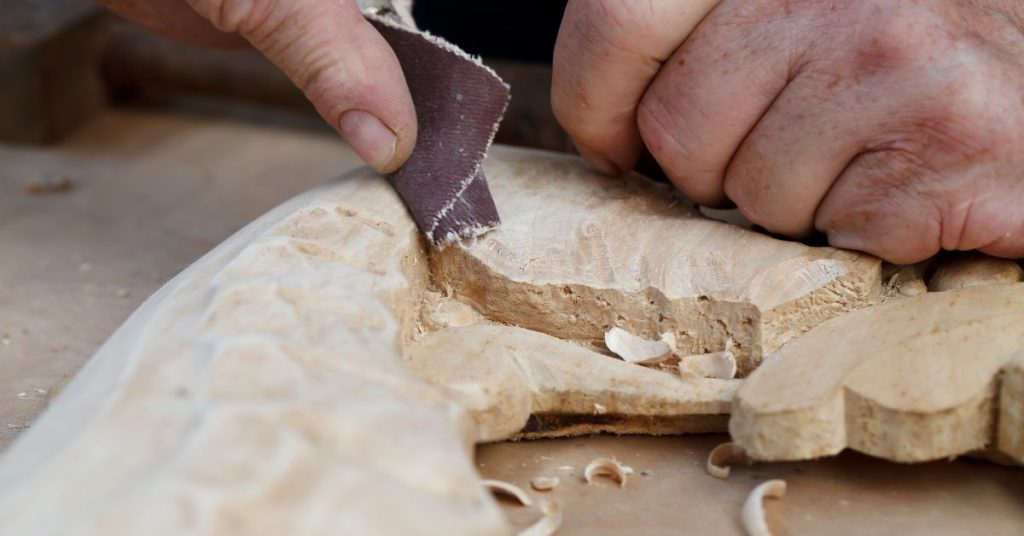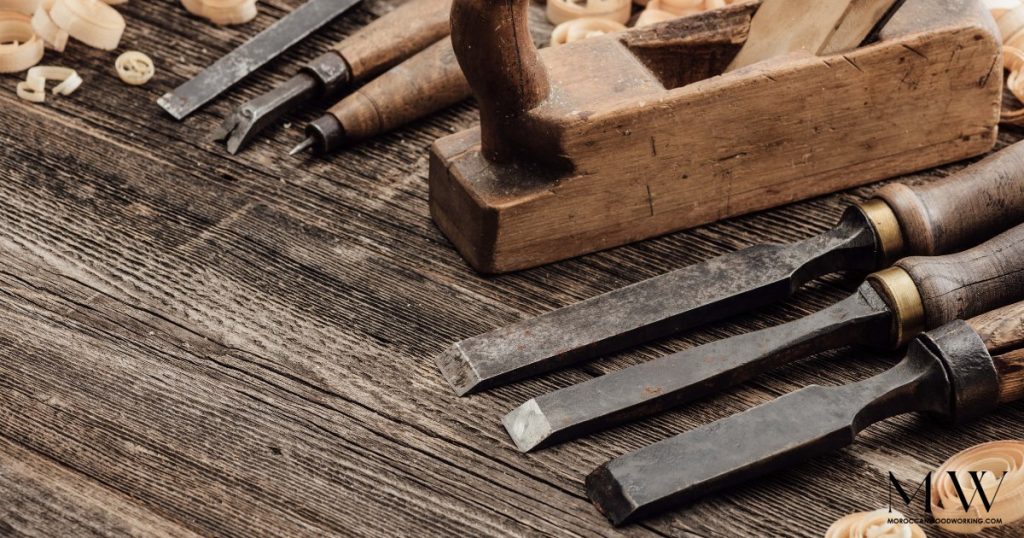Morocco is a country with a long and proud tradition of woodworking. Its history reaches back centuries, to when the first carpenters began crafting furniture for royalty and homes alike.
Moroccan woodworking has changed a lot over the years. In this article, I’ll show you how it happened. First, we’ll learn about the old ways they used before fancy tools. Then, we’ll see how they started using new machines and different styles.
By the end of our exploration, you will have gained an appreciation for how deep-rooted and complex Moroccan woodworking is! Morocco is a country with a long and proud tradition of woodworking. Its history reaches back centuries, to when the first carpenters began crafting furniture for royalty and homes alike.
Over time, people in Morocco have improved their woodworking techniques. They have learned new ways to work with wood, using better tools and getting ideas from different cultures.
In this article, I will tell you how these techniques changed and became what they are today. First, we’ll talk about the old ways people used before they had modern tools. Then, we’ll learn about the new machines they started using and the different styles that became popular.
So, let’s go on a journey through time and discover the fascinating world of Moroccan woodworking!
By the end of our exploration, you will have gained an appreciation for how deep-rooted and complex Moroccan woodworking is!
Traditional Moroccan Woodworking Techniques

In Morocco, people have been doing woodworking for a long time. They learned the techniques from their ancestors and it’s an important part of their culture.
Let’s meet Abdul, a master carpenter from Marrakesh. He is good at what he does because he learned from others and different cultures influenced his work. Abdul uses his hands and special tools like planes, chisels, saws, and gouges to make beautiful designs out of cedar wood. He makes good furniture like chairs, tables, and cabinets.
Abdul knows a lot about working with wood. He knows how to use the materials without wasting anything. He likes to use woods like olive, pine, and walnut because they are easy to find in his region. These woods have unique colors and patterns that make his work look even more amazing.
Many people admire Abdul’s woodworking skills. His work shows why traditional Moroccan woodworking is still loved today. It’s an art that inspires others to appreciate the beauty of wood.
This brings us to the next section about how technology has harmed the industry…
The Introduction Of New Machinery
New machines have changed how people do Moroccan woodworking. These modern machines make things faster and better. They help artisans make beautiful designs while still using traditional methods.
Because of these machines, craftsmen can find good quality wood from different places. They can make amazing pieces of art without hurting the environment. People love these special handmade items more than factory-made things, so there is more demand for them.
The new technology also lets local craftsmen work with designers from other countries. Together, they can create furniture that combines traditional styles with new ideas. This makes the pieces even more unique and exciting.
In the next part, we’ll talk about how foreign styles have influenced Moroccan woodworking. But one thing is for sure: using new technology and being creative will keep making the woodworking industry better and better.
The Influence Of Foreign Styles
Foreign styles have had a significant impact on Moroccan woodworking techniques. A long time ago, people from different countries like Greece, Egypt, Syria, and India had a significant impact on how we do woodworking in Morocco. They shared their ideas and techniques with us, and we learned from them. This mix of different cultures influenced the way we work with wood in Morocco. They shared their ideas and techniques, which helped shape our craft into what it is now. They shared their views and ways of doing things, and that helped shape our craft into what it is today.
In Morocco, the younger craftsmen need to learn from the older ones. They learn from their ancestors and also borrow ideas from other cultures. This mix of traditions and new influences help them create beautiful and unique things.
Keeping these old methods alive is important. The master craftsmen take good care of them so they don’t disappear. Even as new influences come into Morocco, we hope that these special skills will stay with us for a long time. They inspire people all over the world, and we want future generations to enjoy them too.
Transitioning now towards traditional hand tools used in the craft…
Traditional Hand Tools

Moroccan artisans learned new ways of working with wood from different styles. They took these ideas and combined them with their traditional techniques and tools. This made their woodworking even more unique and special. They used special tools like chisels, awls, planes, scrapers, and saws to make detailed designs on things like furniture, boxes, and doors.
They didn’t make fancy pieces, though. They also created simpler things like stools, chairs, and cabinets using both old and new techniques. They used traditional ways of joining pieces together and modern bolts and screws.
These handmade items became popular, not for local people but also for travelers who came to Morocco. People loved authentic and crafted things. The demand for these items grew, so factories started using machines and automated processes to make more of them.
Moroccan woodworking has changed a lot over time. The artisans have mixed different styles and used special tools and machines. This has made their work even more exciting and in demand. People love their beautiful and well-made creations.
The next section will explore this further.
The Emergence Of Industrial Woodworking
Moroccan woodworking techniques have come a long way since their start.
The emergence of industrial woodworking was the next step in this journey, and it brought with it both benefits and drawbacks.
Nowadays, industrial-level craft marketing has become easier with the use of machines that can make a lot of products at once. This helps get things done faster.
Yet, there’s a problem with this: it’s not good for the environment. Making a lot of things in factories can harm our natural resources.
The introduction of machines has changed how Moroccan woodworkers do their jobs. They use advanced tools like saws and drills instead of hand tools. But some craftsmen still prefer to use traditional tools that they have been using for a long time.
Technology has had a big impact on Moroccan woodworking, but not everyone agrees on whether it’s a good thing or not.
As we move forward, we need to think about how new methods will affect ancient skills and the environment. We want to make sure we protect our traditions and our planet for future generations.
This brings us to the impact of technology on woodworking – an important topic deserving further exploration.
The Impact Of Technology On Woodworking
As the years passed, Moroccan woodworkers evolved their techniques to meet the demands of modern life. They embraced technology, which played a major role in shaping the industry and had a noticeable impact on their work.
New tools and technology have changed how Moroccan woodworkers do their jobs. They now use machines like automated saws and routers that make things faster. They can create intricate patterns and designs on furniture.
The materials they use have also improved. They can now use plywood, particleboard, and composite wood products, which gives them more options for designs. These materials are also more affordable, which is helpful when money is tight.
Even with all these advancements, some craftsmen still prefer to use traditional methods. They believe that the quality of their work is better and it’s better for the environment. People appreciate things that skilled craftsmen make by hand. They appreciate the skill of craftsmen who use old-fashioned techniques to make furniture. They use special ways of joining the pieces together, like mortise and tenon joints or dovetailing. Because of this, there is a big demand for this kind of furniture.
So, even as machines become more common, there are still people who appreciate the old ways of doing things. This demand for special and custom-made pieces is keeping traditional skills alive.
The Popularity Of Ornate Designs
For a long time, Moroccan woodworking techniques have been famous. People have loved the fancy and detailed designs that come with these techniques. To create these intricate patterns, artisans use a variety of cutting techniques to etch out their desired outcomes. This table provides an overview of some of the more common methods used:
| Cutting Technique | Description |
| Carving | Using chisels or gouges to shape & sculpt wood |
| Pyrography | Burning lines into the wood with a heated point |
| Intarsia | Inserting pieces of contrasting woods |
| Marquetry | Creating elaborate inlays |
Moroccan woodworking techniques have been popular for a long time, and the fancy designs that go with them are special. Artisans use different cutting techniques to create these detailed patterns. Here’s a table that shows some of the common methods they use:
Skilled craftsmen in Morocco have developed special ways of making furniture to make sure it’s high quality and beautiful. They pass down their knowledge from one generation to the next. When you look at traditional wooden pieces from Morocco, you can see that artisans put a lot of care and attention into the design and finishing. Each piece is unique and made by hand. That’s why people still love Moroccan woodworking today. We can also see how it has evolved and is bringing back traditional craftsmanship.
The Revival Of Traditional Craftsmanship
In the past, some people thought that the old ways of doing Moroccan woodworking would disappear as things became more modern. But if you look closer, you’ll see something different. Craftspeople in Morocco are working hard to bring back these old ways of doing things and keep them alive for the future.
There are groups like The Association Marocaine de Menuiserie et Ebenisterie (AMME) that are getting bigger. They connect with people from different countries too. They teach new skills and share the best ways to do things. This helps create a strong community of experts who want to keep ancient traditions alive in modern times.
Woodworking is still important in many parts of Morocco. It gives people there a chance to make money. In Morocco, some people are good at making furniture with special carvings on them. They spend a lot of time creating beautiful designs. Other people in Morocco start their small businesses and make things for the people who live nearby. They use new tools and technology to help them. These woodworkers are proud of their culture and want to make sure their traditions stay alive. They find ways to use modern tools while still keeping their old ways of doing things.
We’ve come a long way, and now we’re focused on sustainable woodworking. We should be proud of how ancient practices can still thrive today.
The Rise Of Sustainable Woodworking
For centuries, Moroccan woodworking has been a source of pride for many craftsmen and artisans. With the rise in global awareness about practices, sustainable lumber is now more available than ever before.
People who make things out of wood have figured out how to get better at their craft while also taking care of the environment. They use materials that don’t hurt nature, but they still make things that are nice and well-made. They grow and use plants as resources to make their art. This helps them show their traditions and express themselves in their work. These artworks are both useful and help protect the environment. With the right tools and techniques, Moroccan woodworkers can keep getting better at what they do while being.
As time goes on, it will be fascinating to see how far they take these advancements and what new heights they reach in innovation and creativity. As we move forward into the future of Moroccan woodworking, there is no limit to what we can achieve when we combine our knowledge and passion!
The Future Of Moroccan Woodworking
Now that we’ve seen more and more people using ways to work with wood, let’s see what’s coming up for Moroccan woodworking in the future.
Modernization has been a key factor in recent years and there are many positive changes taking place.
Moroccan woodworking is changing and adapting to modern times while preserving its history. Here are five ways it will shape the future:
1. Craftspeople will use better tools and machines to work faster.
2. People will use materials like bamboo and reclaimed wood to support sustainability.
3. Online stores will make it easier for customers worldwide to buy authentic Moroccan products
4. Artisans can showcase their work on social media, connecting with others who share their interests.
5. Collaboration between artisans and designers from different cultures will lead to unique creations.
Moroccan woodworking is changing for the future. They will use better tools, and materials, and sell online. Artisans will share their work on social media and collaborate with designers from other cultures.
Frequent-Asked Questions
How Much Does Traditional Moroccan Woodworking Cost Compare To Industrial Woodworking?
The age-old adage ‘you get what you pay for’ rings true when it comes to traditional Moroccan woodworking.
Traditional Moroccan woodworking costs more, but it’s ergonomic.
When people use traditional methods for woodworking, they don’t need as many tools or energy. They make special things that last a long time and machines can’t make the same.
Investing in traditional Moroccan woodworking is a great idea for unique, high-quality craftsmanship.
What Are The Environmental Impacts Of Modern Woodworking Techniques?
Modern woodworking techniques have harmed the environment by using a lot of energy and creating waste.
Skilled craftsmen are working to find better ways to make more sustainable things. They want to use fewer resources and make less waste.
Craftsmen are trying to find better ways to make things that don’t hurt the environment. They want to use less stuff and make less waste.
Making things the traditional Moroccan way can cost more, but it’s better for the environment and the stuff lasts longer.
How Has The Moroccan Woodworking Industry Changed Over Time?
The Moroccan woodworking industry has changed over time. In the past, skilled artisans used their hands to cut and shape wood into traditional-style furniture pieces.
Nowadays, thanks to better machines, it’s easier to make lots of wooden things without losing quality. People also care about the environment, so they use sustainable methods to protect it.
What Types Of Materials Did The Traditional Moroccan Woodworking Used?
Skilled Moroccan woodworkers use local materials such as cedar and olive wood to create amazing crafts. They shape these raw materials into beautiful art using saws, chisels, and planes. With their expert skills, Moroccan woodworkers craft objects of lasting beauty that people can enjoy for a long time.
What Are The Benefits Of Using Traditional Tools And Techniques Over Modern Machinery?
Moroccan woodworkers have their special ways of working with wood that they’ve been using for hundreds of years. They use special tools and techniques that make their work unique. These traditional methods have benefits that machines can’t copy.
By using these methods, artisans develop valuable skills and connect with the past in a way that machines cannot replace.
Moreover, traditional tools allow for more customization compared to mass-produced machine-made furniture.
In the end, the distinctive results speak volumes about the value of sticking to tradition.
Moroccan woodworking is like a special kind of art. It has changed and gotten even better over time. Skilled craftsmen work hard to make beautiful things that will never go out of style.







